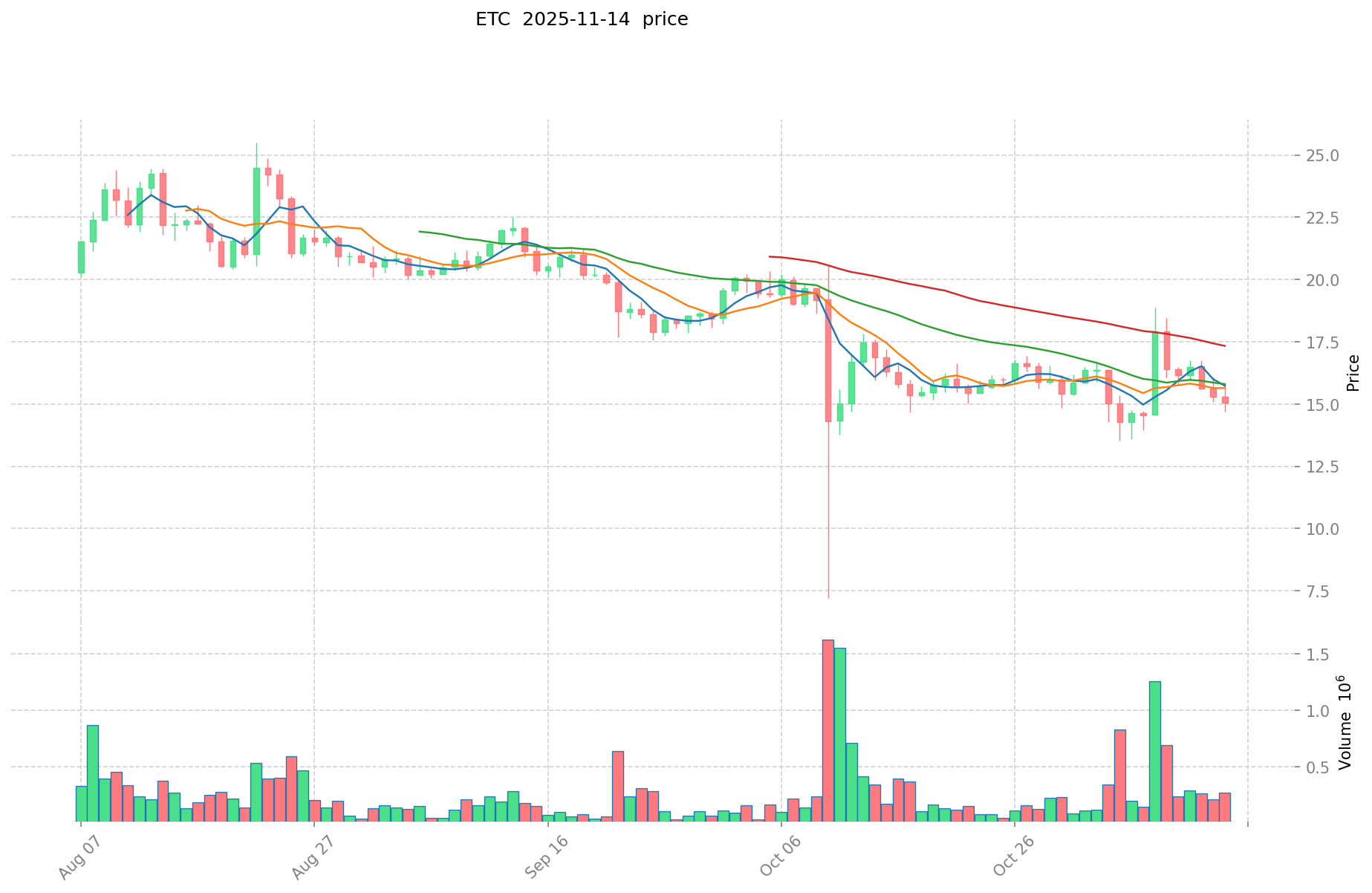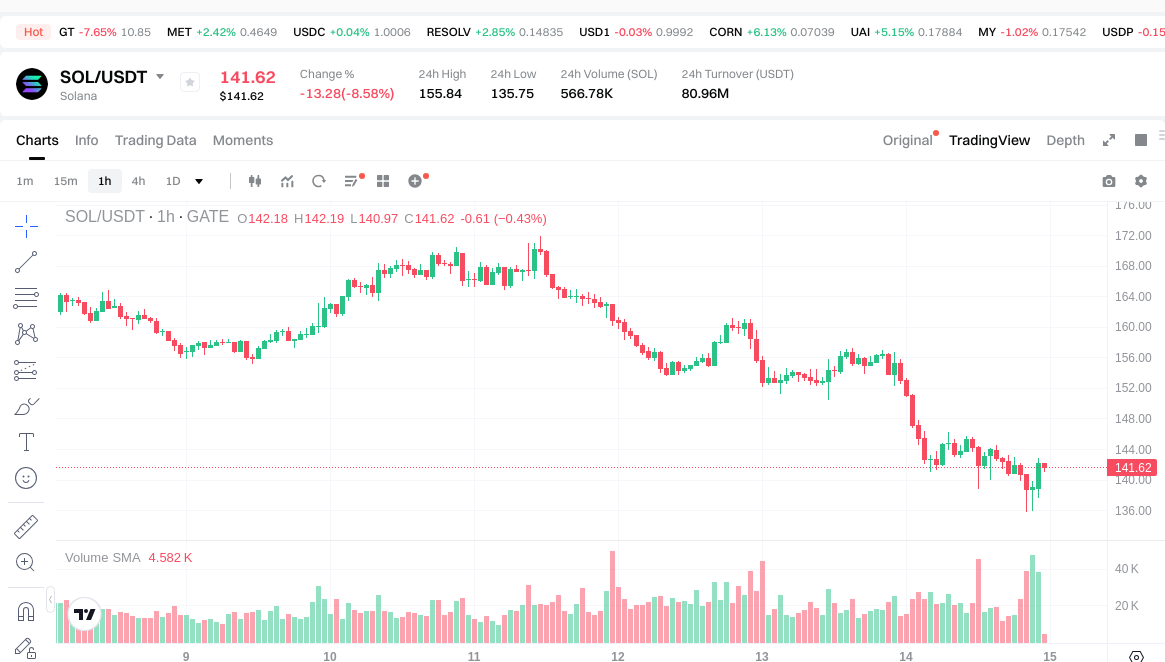ETC vs SOL: Comparing the Potential of Ethereum Classic and Solana in the Evolving Crypto Landscape
Introduction: ETC vs SOL Investment Comparison
In the cryptocurrency market, Ethereum Classic vs Solana has always been a topic that investors can't ignore. The two not only have significant differences in market cap ranking, application scenarios, and price performance, but also represent different cryptocurrency positions.
Ethereum Classic (ETC): Since its launch in 2016, it has gained market recognition for its commitment to the "code is law" principle and as a continuation of the original Ethereum blockchain.
Solana (SOL): Introduced in 2020, it has been hailed as a high-performance blockchain protocol designed for scalability without compromising decentralization or security.
This article will comprehensively analyze the investment value comparison between ETC and SOL, focusing on historical price trends, supply mechanisms, institutional adoption, technological ecosystems, and future predictions, and attempt to answer the question that investors are most concerned about:
"Which is the better buy right now?"
I. Price History Comparison and Current Market Status
ETC and SOL Historical Price Trends
- 2021: ETC reached its all-time high of $167.09 on May 7, 2021.
- 2025: SOL hit its historical peak of $293.31 on January 19, 2025.
- Comparative analysis: ETC has fallen from its all-time high of $167.09 to the current price of $14.86, while SOL has declined from its peak of $293.31 to $141.4.
Current Market Situation (2025-11-14)
- ETC current price: $14.86
- SOL current price: $141.4
- 24-hour trading volume: ETC $5,951,651.62 vs SOL $80,844,942.99
- Market Sentiment Index (Fear & Greed Index): 16 (Extreme Fear)
Click to view real-time prices:
- Check ETC current price Market Price
- Check SOL current price Market Price


II. Core Factors Affecting the Investment Value of ETC vs SOL
Supply Mechanism Comparison (Tokenomics)
- ETC: Fixed supply cap of 210.7 million coins, with no ability to change the monetary policy, making it deflationary by design
- SOL: Disinflationary model with decreasing inflation rate over time, starting at 8% annually and reducing to approximately 1.5% in the long term
- 📌 Historical Pattern: Fixed supply assets like ETC tend to perform better during periods of high inflation, while SOL's decreasing inflation model aims to balance network security with price appreciation potential.
Institutional Adoption and Market Applications
- Institutional Holdings: SOL has gained significantly more institutional interest, with Grayscale, VanEck, and other investment firms creating Solana-based products
- Enterprise Adoption: SOL leads in payment applications, DeFi platforms, and NFT marketplaces, while ETC remains primarily a store of value with limited application development
- Regulatory Attitudes: ETC benefits from regulatory clarity as a PoW asset similar to Bitcoin, while SOL faces more regulatory uncertainty as a PoS network with validator concentrations
Technical Development and Ecosystem Building
- ETC Technical Upgrades: Maintains backward compatibility with Ethereum's pre-PoS codebase but has slower development activity and fewer core developers
- SOL Technical Development: Regular upgrades focusing on scalability and transaction throughput, though facing challenges with network outages
- Ecosystem Comparison: SOL has a vastly larger ecosystem spanning DeFi, NFTs, gaming, and payments with over $2 billion in TVL, while ETC's ecosystem remains minimal with few active dApps
Macroeconomic Factors and Market Cycles
- Performance During Inflation: ETC's fixed supply model theoretically offers better inflation resistance, though historical data shows mixed results
- Macroeconomic Monetary Policy: Interest rate hikes typically affect higher risk assets like SOL more severely than established assets like ETC
- Geopolitical Factors: ETC's proof-of-work consensus potentially offers more censorship resistance in restrictive jurisdictions, while SOL's higher throughput benefits cross-border payment applications in permissive environments
III. 2025-2030 Price Prediction: ETC vs SOL
Short-term Prediction (2025)
- ETC: Conservative $10.70 - $14.86 | Optimistic $14.86 - $20.36
- SOL: Conservative $134.24 - $141.31 | Optimistic $141.31 - $149.79
Mid-term Prediction (2027)
- ETC may enter a growth phase, with expected prices of $17.40 - $26.83
- SOL may enter a consolidation phase, with expected prices of $164.88 - $226.71
- Key drivers: Institutional capital inflow, ETF, ecosystem development
Long-term Prediction (2030)
- ETC: Base scenario $22.30 - $34.84 | Optimistic scenario $34.84 - $51.56
- SOL: Base scenario $140.04 - $233.40 | Optimistic scenario $233.40 - $263.74
Disclaimer: This analysis is for informational purposes only and should not be considered as financial advice. Cryptocurrency markets are highly volatile and unpredictable. Always conduct your own research before making any investment decisions.
ETC:
| 年份 | 预测最高价 | 预测平均价格 | 预测最低价 | 涨跌幅 |
|---|---|---|---|---|
| 2025 | 20.36368 | 14.864 | 10.70208 | 0 |
| 2026 | 24.3070992 | 17.61384 | 13.0342416 | 18 |
| 2027 | 26.829401088 | 20.9604696 | 17.397189768 | 41 |
| 2028 | 33.93080818848 | 23.894935344 | 21.98334051648 | 60 |
| 2029 | 40.7671491903984 | 28.91287176624 | 22.8411686953296 | 94 |
| 2030 | 51.563215507912416 | 34.8400104783192 | 22.297606706124288 | 134 |
SOL:
| 年份 | 预测最高价 | 预测平均价格 | 预测最低价 | 涨跌幅 |
|---|---|---|---|---|
| 2025 | 149.7886 | 141.31 | 134.2445 | 0 |
| 2026 | 197.947048 | 145.5493 | 117.894933 | 2 |
| 2027 | 226.70758968 | 171.748174 | 164.87824704 | 21 |
| 2028 | 225.1275064792 | 199.22788184 | 129.498123196 | 40 |
| 2029 | 254.61323299152 | 212.1776941596 | 150.646162853316 | 50 |
| 2030 | 263.7368738403828 | 233.39546357556 | 140.037278145336 | 65 |
IV. Investment Strategy Comparison: ETC vs SOL
Long-term vs Short-term Investment Strategy
- ETC: Suitable for investors seeking store of value and potential hedge against inflation
- SOL: Suitable for investors focused on ecosystem growth and application development potential
Risk Management and Asset Allocation
- Conservative investors: ETC: 70% vs SOL: 30%
- Aggressive investors: ETC: 40% vs SOL: 60%
- Hedging tools: Stablecoin allocation, options, cross-currency portfolios
V. Potential Risk Comparison
Market Risk
- ETC: Limited ecosystem growth may lead to decreased investor interest
- SOL: Higher volatility due to its relatively newer status in the market
Technical Risk
- ETC: Lower development activity, potential for reduced network security
- SOL: Network outages, scalability challenges under high load
Regulatory Risk
- Global regulatory policies may have different impacts on ETC (PoW) and SOL (PoS)
VI. Conclusion: Which Is the Better Buy?
📌 Investment Value Summary:
- ETC advantages: Fixed supply, established history, potential inflation hedge
- SOL advantages: Rapid ecosystem growth, high performance, institutional interest
✅ Investment Advice:
- New investors: Consider a balanced approach with a slight bias towards SOL for growth potential
- Experienced investors: Allocate based on risk tolerance, potentially favoring SOL for higher returns
- Institutional investors: Evaluate SOL for its ecosystem potential, while considering ETC for portfolio diversification
⚠️ Risk Warning: The cryptocurrency market is highly volatile, and this article does not constitute investment advice. None
VII. FAQ
Q1: What are the key differences between ETC and SOL? A: ETC has a fixed supply cap of 210.7 million coins and uses proof-of-work consensus, while SOL has a disinflationary model with decreasing inflation rate and uses proof-of-stake. SOL has a larger ecosystem and more institutional adoption, but ETC offers potential inflation resistance.
Q2: Which cryptocurrency has performed better historically? A: SOL has shown stronger price performance, reaching an all-time high of $293.31 in 2025, compared to ETC's peak of $167.09 in 2021. However, both have experienced significant declines from their all-time highs.
Q3: How do the ecosystems of ETC and SOL compare? A: SOL has a much larger and more diverse ecosystem, with over $2 billion in Total Value Locked (TVL) across DeFi, NFTs, gaming, and payments. ETC's ecosystem remains minimal with few active decentralized applications.
Q4: What are the main risks associated with investing in ETC and SOL? A: For ETC, risks include limited ecosystem growth and lower development activity. SOL faces risks such as network outages, scalability challenges, and potentially higher regulatory scrutiny due to its proof-of-stake model.
Q5: How might macroeconomic factors affect ETC and SOL differently? A: ETC's fixed supply model may offer better theoretical resistance to inflation, while SOL might be more sensitive to interest rate hikes as a higher-risk asset. Geopolitical factors could favor ETC in restrictive jurisdictions due to its proof-of-work consensus.
Q6: What are the long-term price predictions for ETC and SOL? A: By 2030, ETC is predicted to reach between $22.30 and $51.56 in optimistic scenarios, while SOL is expected to be between $140.04 and $263.74. However, these predictions are speculative and subject to market volatility.
Q7: How should investors allocate between ETC and SOL? A: Conservative investors might consider allocating 70% to ETC and 30% to SOL, while aggressive investors could opt for 40% ETC and 60% SOL. The exact allocation should be based on individual risk tolerance and investment goals.
Share
Content